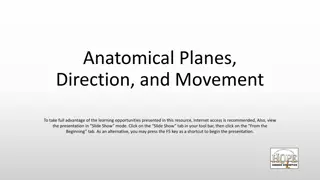Understanding Equations of Planes in Three-Dimensional Geometry
In this module, we delve into the concept of planes in three-dimensional geometry. Starting with the definition of a plane and its general equation, we explore intercept form, normal form, and practical examples. Equations, concepts, and applications are explained methodically to enhance understanding.
Download Presentation

Please find below an Image/Link to download the presentation.
The content on the website is provided AS IS for your information and personal use only. It may not be sold, licensed, or shared on other websites without obtaining consent from the author. Download presentation by click this link. If you encounter any issues during the download, it is possible that the publisher has removed the file from their server.
E N D
Presentation Transcript
Distance Learning Programme: An Initiative by AEES, Mumbai Class : XII Subject : Mathematics Chapter : Three Dimensional Geometry Module : 3/5 By: Anuj Kumar PGT(Mathematics) AECS, Indore 1
Previous Knowledge: In the previous modules we have studied the following Direction Cosines & Direction Ratios of a line. Vector & Cartesian forms of Equations of lines in space. Angle between two lines Shortest distance between two lines Point of intersection of two lines Foot of perpendicular and its length Image of a point with respect to a line. Content of Module 3: Equation of plane 2
The Plane Definition: A plane can be defined as a surface such that if any two points A, B are taken on it, the line segment AB lies on the surface i.e., every point on the line segment AB lies on the plane. Some planes we have studied in class XI as XY, YZ and ZX planes then above definition can be verified for these planes also i. e. if two points are taken on either of surface as XY or YZ or ZX then their line joining will also be there on the same surface. As we have studied equation of line, here also we will be going through some equations of planes also, which are as follows- 1. General equation of plane: Every equation of first degree ax + by + cz + d = 0 represents a plan where a, b & c can not be equal to zero simultaneously or a2 + b2 + c2 0. 3
2. Intercept form of the plane: If plane Ax + By + Cz + D = 0 is not passing through origin and making intercepts of lengths a, b and c on X, Y and Z axis respectively. Since the plane is not passing through origin therefore D 0 and it is passing through (a, 0, 0), (0, b, 0) & (0, 0, c) i.e. aA + D = 0 A = ? bB + D = 0 B = ? cC + D = 0 C = ? Now the equation plane will be ? ? It is known as intercept form the plane. ? ? ? ?? ? ?+? ?? ? ?+? ?? + ? = ? ?= 1 ?? ? ?? ? ?? = ? 4
3. Normal form of the plane: Let us consider a plane whose perpendicular distance form origin is d ( 0). If ?? is the normal form the origin to the plane and ? is unit normal vector along ?? If P (x, y, z) with posion vector ?? = ? = ?? + ?? + ?? be a point on the palne then ?? ?? ?? .?? = 0. (?? ?? ).?? = 0 ? ?? .?? = 0 Since d 0 & ? .? = 1 therefore ? .? = ? (vector form of equation of plane) Let l, m, n be the direction cosines of ? then ? = ?? + ?? + ?? then Cartesian form of the equation of the plane is ?? + ?? + ?? . ?? + ?? + ?? = ? ?? + ?? + ?? = ?. Note-6: If d is the distance of the plane from the origin and l, m , nare the dc s of the normal to the plane then coordinates of foot of perpendicular is (ld, md, nd). then ?? = ?? . 5
Note-7: If plane is passing through origin (0, 0, 0) then equation of plane will be lx + my + nz = 0. Example-13: Find the equation of the plane whose distance form origin is 7 units and which is normal to the vector 3? + 5? 6? . Solution: Since d = 7 units and ? = 3? + 5? 6? therefore 3? +5? 6? 9+25+36=3? +5? 6? 70 The vector equation of the plane is ? .? = ? ? .3? +5? 6? 70 The Cartesian equation of the plane is ?? + ?? + ?? .3? +5? 6? 70 3? + 5? 6? = 770 ? = = 7 = 7 6
Exapmle-14: Find the normal form of the plane 2x + 3y z = 5. Solution:Since the dr s of the normal to the plane are 2, 3, 1 therefore the dc s are 22+32+ 12 , If both sides of given equation of plane are divided by 14 then normal form of the plane will be 14? + Where 2 3 1 2 3 1 14 22+32+ 12 22+32+ 12 , 14, 14, 2 3 1 6 14 14? 6 14 is the distance of the plane from origin and the coordinates of foot of perpendicular drawn from origin is (ld, md, nd) 2 14. 14= 6 3 6 1 14. 14??12 6 14,18 14??6 6 7,9 7, 3 7 14, 14. 14, 14, 7
4. Equation of a plane perpendicular to a given vector and passing through a given point: Let a plane passes through A(x1, y1, z1) with position vector ?? = ? = ?1? + ?1? + ?1? and perpendicular to the vector ? . If P (x, y, z) with posion vector ?? = ? = ?? + ?? + ?? be a point on the palne then ?? ? ?? .? = 0 ?? ?? .? = 0 ? ? .? = 0 (Vector form) Let ? = ?? + ?? + ?? then Cartesian form the plane will be as ?? + ?? + ?? ?1? ?1? ?1? . ?? + ?? + ?? = 0 A(x x1) + B (y y1) + C (z z1) = 0 Example-14: Find the equation of planes passes through (2, 1, 1) and perpendicular to the vector 4? + 2? 3? Solution: Here ? = 2? ? + ? ???? = 4? + 2? 3? then equation of plane is ? ? .? = 0 ? 2? ? + ? .4? + 2? 3? = 0 (Vector Form) (?? + ?? + ?? ) 2? ? + ? .4? + 2? 3? = 0 4(x 2) + 2(y + 1) 3(z 1) = 0 4x + 2y 3z = 3 (Cartesian Form) 8
5. Equation of a plane passes through three non collinear points: Let R(?1, ?1,?1), S(?2, ?2,?2) & T(?3, ?3,?3) be three non collinear points on the plane with position vectors = ? = ?1? + ?1? + ?1? , ?? = ? = ?2? + ?2? + ?2? & ?? = ? = ?3? + ?3? + ?3? respectively. Since vectors ?? & ?? are on the plane therefore ?? perpendicular vector to the plane. If P (x, y, z) with posion vector ?? palne then ?? . ?? ?? = 0 ?? ?? is a = ? = ?? + ?? + ?? be a point on the ? ? . ? ? ? ? = 0(Vector Form) On substituting the posion vectors of ? ,? ,? & ? in vector form then we will get ? ?1 ? ?1 ? ?1 ?2 ?1 ?2 ?1 ?2 ?1 ?3 ?1 ?3 ?1 ?3 ?1 = 0(Cartesian Form) 9
Example-15: Find the equation of the plane passes through (2, , 2, 2), (1, 1, 1) & (1, 1, 2). Solution: We have here? = 2? 2? + 2? ,? = ? + ? + ? & ? = ? ? + 2? then equation of plane is ? ? . ? ? ? ? = 0 ? ( 2? 2? + 2? ).3? + 3? ? 3? + ? + 2? = 0(Vector Form) ? ?1 ?2 ?1 ?3 ?1 ? + 2 ? ?1 ?2 ?1 ?3 ?1 ? + 2 3 1 ? ?1 ?2 ?1 ?3 ?1 ? 2 1 0 The cartesian form of the plane will be as = 0 ? ( 2) 1 ( 2) 1 ( 2) x 3y 6z + 8 =0 Note-8: Sometimes the problem may be asked with three collinear points that does not mean there is no plane but there exist infinitely many planes passes through collinear points as pages of a book. It can be verified with the points (1, 1, 1), (6, 4, 5), ( 4, 2, 3) ? ( 2) 1 ( 2) 1 ( 2) ? 2 1 2 2 2 = 0 = 0 3 3 10
Thank you End of Module 3/5 11























